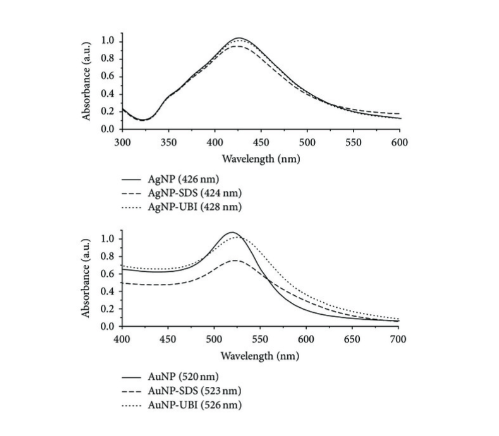文献:Antibacterial Efficacy of Gold and Silver Nanoparticles Functionalized with the Ubiquicidin (29–41) Antimicrobial Peptide
文献链接:
https://www.hindawi.com/journals/jnm/2017/5831959/
作者:
Enrique Morales-Avila, Guillermina Ferro-Flores, Blanca E. Ocampo-García, Gustavo López-Téllez, Johnny López-Ortega, Diana G. Rogel-Ayala, Diego Sánchez-Padilla
相关产品:
磷脂-聚乙二醇-抗菌肽 DSPE-PEG-UBI
原文摘要:
Recent studies have demonstrated that drug antimicrobial activity is enhanced when metallic nanoparticles are used as an inorganic support, obtaining synergic effects against microorganisms. The cationic antimicrobial peptide ubiquicidin 29–41 (UBI) has demonstrated high affinity and sensitivity towards fungal and bacterial infections. The aim of this research was to prepare and evaluate the antimicrobial efficacy of engineered multivalent nanoparticle systems based on silver or gold nanoparticles functionalized with UBI. Spectroscopy techniques demonstrated that NPs were functionalized with UBI mainly through interactions with the -NH2 groups. A significant increase in the antibacterial activity against Escherichia coli and Pseudomonas aeruginosa was obtained with the conjugate AgNP-UBI with regard to that of AgNP. No inhibition of bacterial growth was observed with AuNP and AuNP-UBI using a nanoparticle concentration of up to 182 μg mL−1. Nonetheless, silver nanoparticles conjugated to the UBI antimicrobial peptide may provide an alternative therapy for topical infections.
当金属纳米颗粒用作无机载体时,药物的抗菌活性会增强,从而获得对抗微生物的协同作用。阳离子抗菌肽ubiquicidin 29-41(UBI)具有高亲和力和敏感性。该文献的目的是制备和评估基于UBI功能化的银或金纳米颗粒的工程多价纳米颗粒系统的抗菌效果。

图为:UBI肽功能化银和金纳米颗粒光谱
纳米粒子与UBI肽的偶联和标准化
为了确定NP-UBI胶体悬浮液的稳定性,不同体积(从20 μL至100 μL),共20个 μM UBI添加到1 mL稳定的SDS NP,然后在室温下搅拌15分钟。然后测量Z电位(Microtrac,USA)以确定肽对胶体稳定性的影响。一旦选择了稳定的悬浮液,其比例如下:750 μL UBI(29-41)20 μM( mol)加入到25 mL稳定的SDS NP。计算并调整肽/NP放射性,以获得每个纳米颗粒5–20个肽。使用超速离心(22000 在°C下以rpm旋转20分钟)。分光光度法将AuNP-UBI或AgNP-UBI的悬浮液调节至吸光度为1 并储存以备进一步使用。
通过光谱学技术表明,UBI主要通过与-NH2基团的相互作用对纳米颗粒进行功能化。与AgNP相比,缀合物AgNP-UBI对大肠杆菌和铜绿假单胞菌的抗菌活性提高。

 2025-04-18 作者:wff 来源:
2025-04-18 作者:wff 来源:

